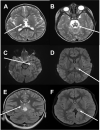Acute Necrotizing Encephalopathy: 2 Case Reports on RANBP2 Mutation
- PMID: 34377735
- PMCID: PMC8326991
- DOI: 10.1177/2329048X211030751
Acute Necrotizing Encephalopathy: 2 Case Reports on RANBP2 Mutation
Abstract
Infection-induced acute encephalopathy 3 (IIAE3) is an autosomal dominant disease resulting from a pathogenic variant in the RANBP2 gene. IIAE3 results in the susceptibility to the recurrence of acute necrotizing encephalopathy (ANE1) which presents as bilateral symmetric thalamic, midbrain and/or hindbrain lesions that typically develops within 1-4 days post-acute viral infection, commonly occurring before age 6.1-6 These case reports highlight a retrospective analysis of clinical data and radiographic studies on 2 ANE1 cases from our institution. The novel p.Leu450Phe variant of the RANBP2 gene was analyzed using in silico algorithms (PolyPhen-2, SIFT, Mutationtaster) which suggests the p.Leu450Phe variant is probably deleterious.7 An expansion of documented ANE1 case presentations and clinically significant RANBP2 gene mutations has the potential to improve long term outcomes if more informed therapeutic decision making can be achieved.
Keywords: EEG; RANBP2 mutation; genetics; neuroimaging; pediatrics; seizure; status epilepticus.
© The Author(s) 2021.
Conflict of interest statement
Declaration of Conflicting Interests: The authors declared no potential conflicts of interest with respect to the research, authorship, and/or publication of this article.
Figures

References
-
- Chow CK, Ma CKL. Presentation and outcome of acute necrotizing encephalopathy of childhood: a 10-year single-center retrospective study from Hong Kong. J Child Neurol. 2020;35(10):674–680. doi:10.1177/0883073820927915 PMID: 32493103. - PubMed
-
- Işıkay S, Şahin Y. RANBP2 mutation in clinically undiagnosed acute necrotizing encephalopathy. Indian J Pediatr. 2018;85(9):820–821. doi:10.1007/s12098-018-2678-0 PMID: 29687329. - PubMed
-
- Singh RR, Sedani S, Lim M, Wassmer E, Absoud M. RANBP2 mutation and acute necrotizing encephalopathy: 2 cases and a literature review of the expanding clinico-radiological phenotype. Eur J Paediatr Neurol. 2015;19(2):106–113. doi:10.1016/j.ejpn.2014.11.010 - PubMed
Publication types
LinkOut - more resources
Full Text Sources
Miscellaneous

